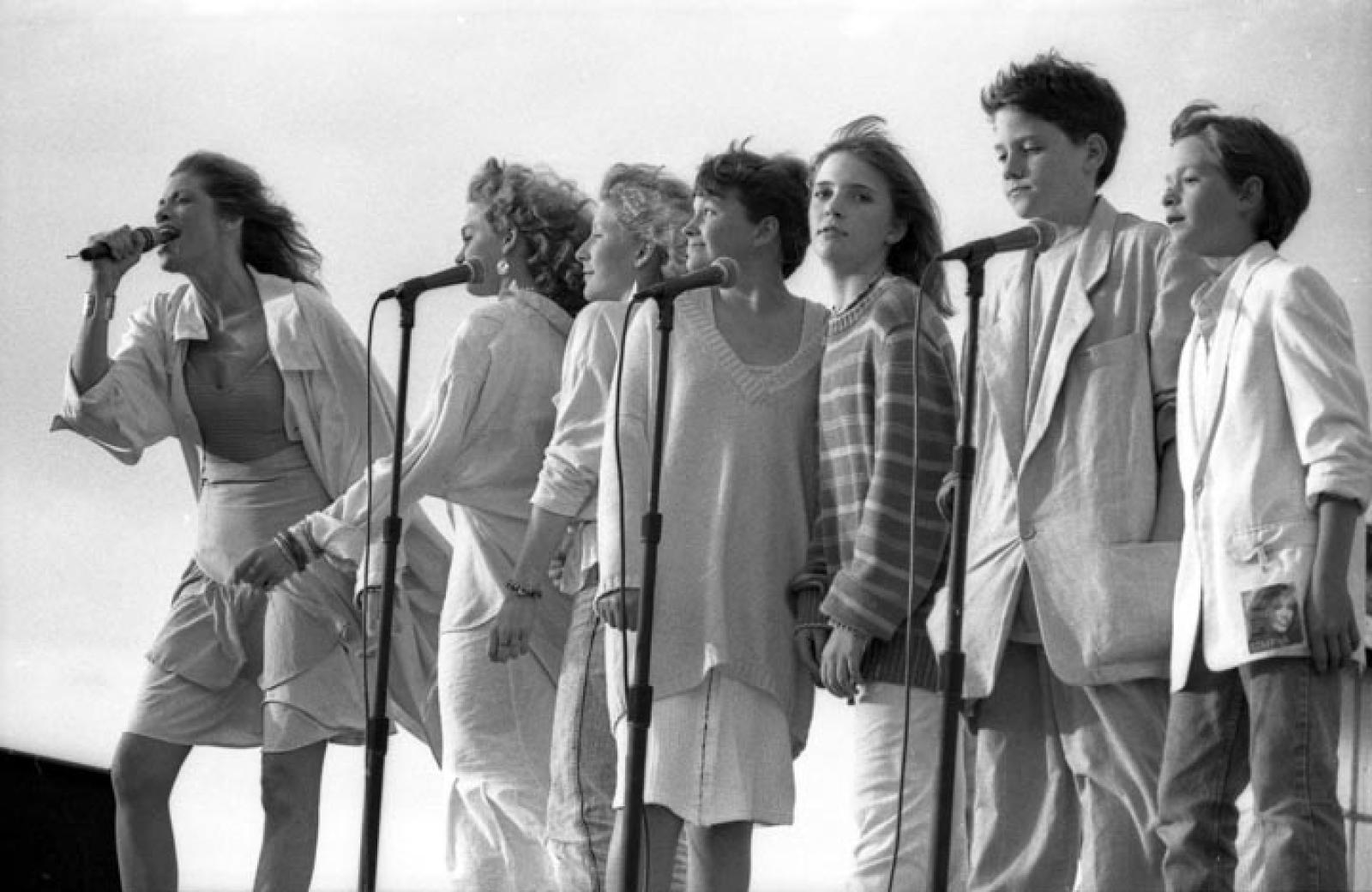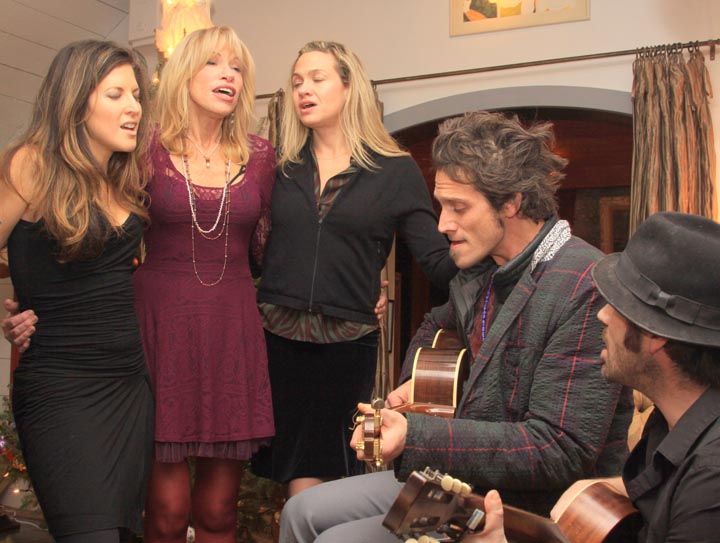Carly Simon, especially for those who live on or visit Martha’s Vineyard, is a bold-faced name. In fact, she has been famous for so long it is as if she were born famous; biding her time in the womb, say, by humming the first bars of Anticipation. Such is the price of fame, this distorted view by those on the outside looking in. We see only the finished product, the glamorous stage presence, so natural, again as if she had rocked her own delivery room with a chorus of You’re So Vain. But this is a false picture, one that does not include the shy stutterer who achieved her success the old-fashioned way, with a lot of very hard work.
A new biography of Carly Simon appears in stores on Jan. 10 and sets the record straight. Titled More Room in a Broken Heart, the book is written by rock biographer Stephen Davis.
This is Mr. Davis’s 16th book. He is the best selling author of Hammer of the Gods, the story of the early days of Led Zeppelin. He has also written biographies of Jim Morrison, Guns and Roses, Aerosmith, and Bob Marley, to name a few.
The difference with this book, however, is that Mr. Davis is not just a journalist with respect to the Simon family. He is also a friend, having known Carly Simon since 1967, when he accompanied his buddy, Peter Simon (Carly’s younger brother), home from college.
Because of his relationship with the Simon family, Mr. Davis is able to provide a unique and intimate perspective on Carly’s career. The book is officially categorized as unauthorized, but Carly was, in Mr. Davis’s words, “very helpful in many ways.” She gave him access to old memoirs and helped him with accuracy and dates.
Writing about a friend, however, is not without its pitfalls. Ms. Simon is not happy with the book. Some say extremely unhappy (she declined to comment to the Gazette this week).
The book is not a press release, merely recounting her successes, and it does frequently dip into the turbulent waters of her love life. As Mr. Davis said to her: “Look, if you like this book, I haven’t done my job.” Mostly, though, it is a flattering portrait in that it lays down the bread crumbs of how Ms. Simon first became a rock star and has continued to remain a force in the world of music for nearly four decades, and counting.
One of the myths the book debunks about Carly Simon is that she was born rich and as a result success arrived easily, with no more effort than it took to ring the maid’s bell. After all, her father, Richard Simon, was one of the founders of the publishing powerhouse, Simon and Schuster. And while it is true that Carly’s childhood did not take place on the mean streets of town — George Gershwin, Albert Einstein and Eleanor Roosevelt were lunch guests, Jackie Robinson played second base at backyard softball games at their Stamford country home and Pete Seeger was her kindergarten music teacher — by the time she tried to break into the music scene, the money truck had driven to a new location. After Simon and Schuster was sold to Marshall Field 3rd, Mr. Simon was edged out of the business, his health went into decline and his emotional state became near catatonic.
Carly, usually in her older sisters’ shadows, had always tried to win her father’s approval by being the clown, but for the most part she was reserved, with a severe stutter holding her back in most social situations. Music became her outlet, and, in fact, one of the early ways she dealt with her stutter was by syncopating her speech to various rhythms. As a result of her childhood difficulties, though, a sense of crippling stage fright continued to haunt her throughout her career.
In an interview with the Gazette, Mr. Davis said Carly told him one of her criticisms of the book was that “The problem with this text is that the first half is so much better than the second half.”
She’s right and even Mr. Davis agrees, in part because this is the nature of the rock biography. It is hard to beat the climb to the top, from unknown to top-of-the-charts superstar, for sheer narrative pleasure. Add to this the singer-songwriter movement of the late 1960s and 70s, including Bob Dylan, Joan Baez, and Joni Mitchell, the California music scene in ascendence with The Doors, Grateful Dead and Jackson Brown, plus Al Green and Marvin Gaye; the list is long and illustrious. Sprinkle in a bit of Hollywood stardust in the form of 70s cool with Jack Nicholson and Warren Beatty and, say what you will about today’s stars, but it is hard to beat that era for creative icons.
Amidst this crowd Carly Simon not only managed to hold her own, she at times eclipsed them all in sales. Her first big hit, That’s the Way I’ve Always Heard It Should Be, established her as not just a star, but a spokeswoman for her generation.
Another huge star from that era plays a large part in the book. This should come as no surprise, as he was Carly Simon’s husband for nine years. James Taylor does not come across as well as Carly, though. During much of their time together he was using heroin and, according to the book, a distracted and absent father. But it is during their marriage that the book becomes a true Vineyard story. James and Carly essentially moved to the Island in the 1970s, building their home on Lambert’s Cove, bonding with locals and bringing with them their circle of celebrities, including much of the cast of Saturday Night Live. John Belushi often took the kids for ice cream.
The middle of the book charts the careers of both J.T. and Carly, and again this sojourn into the past helps rekindle just how astonishing was this part of Carly’s life. She and her husband essentially traded spots at number one, or at least in the top 10, for much of their marriage, their competition fueling each one to greater creative heights. The two sang on each other’s albums, combined forces for the hit Mockingbird, and toured together while raising a family.
But J.T. is not the only other Vineyard presence in the book. In fact, much of the later chapters detail many of the collaborations Carly had with her Island friends, working on movie scores with Mike Nichols, children’s books with Jacqueline Onassis and local artist Margot Datz, for example.
Stephen Davis feels that rock biographies should have some sort of moral compass. “This coming from the guy who wrote Hammer of the Gods, which was mostly about depravity,” he said with a chuckle.
Concerning More Room in a Broken Heart, Mr. Davis said his goal was to chronicle, “how this woman came from actually a troubled childhood and completely dominated the artistic part of her generation and continued to do so into her seventh decade.”
In this respect, he succeeded.










Comments
Comment policy »